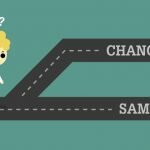Personalization is one of those words that’s not quite a buzz word… but is also rarely defined. What is personalization? It’s a new technology, it’s an opportunity for better experiences, and it’s hard to do well. Good personalization feels like magic, but it takes a lot of prep work.
Simply put, the technology in this space is far outpacing the design practice.
UX in the Age of Personalization (A List Apart)
Based on some recent reading and work creating personalized experience, I would break personalization down into three categories:
- Segmentation
- Customization
- Targeting
Segmentation
Segmentation is what I have previously called “personalization by audience.” It’s a style of personalization based on understanding a subset of people, e.g. a persona type or group of people from a certain location.
Based on this information, you might provide information specific to people with children or people in cold weather climates.
Customization
I’ve referred to customization in the past as “user-based.” But Nick Babich has a more descriptive explanation:
Customization lets users make their own selections about what they want to see, or set preferences for how information is organized or displayed.
The Difference Between Customization and Personalization (UX Planet)
In other words, customization is based on a person saying “I like information about cats” or “I want to see clothing of this style.” It can be as simple as a filter, or as complex as tracking cookies to remember what someone has previously chosen as preferences.
Customization is easiest in post-login experiences, where a person’s selections can be saved and expanded on over time.
Targeting
Although different articles have different terms for this third type, I call it “targeting.” This type of personalization is based on a person’s behaviors, and can’t be done without machine learning to aid. (Otherwise we wind up creating unique content types for millions of potential users.)
Because targeting can be so complicated, the most important part is to identify the goal of targeting. Why do you want to target your users? What benefits will they get?
Targeting has the highest risk of “creep factor” – or providing something so accurate (or so inaccurate) that your audience is concerned about their privacy.
Why Personalize?
Whenever I ask someone why they want to create a personalized experience, they say “to make my audience feel like I know them better.” But this, to me, is not enough.
Returning to Colin Eagan’s article, there are three* reasons to personalize. I’ve amended the language slightly, but here they are:
- To simplify the tasks the user needs to complete
- In order to cross-sell products
- To enrich the user’s experience
*Colin actually has four reasons. He suggests “to alert” is another reason to personalize, but I see this as a variation on “simplify.”
| Simplify | Cross-sell | Enrich | |
| Segmentation | Quick link to boots | Buy winter boots | Read about the best boots |
| Customization | See boots you previously liked | Find coats that match your boots | Watch videos (you said you prefer videos to aritcles) |
| Targeting | Here’s the boot you Googled last week | Other people your age who looked at boots bought hats too | Here’s an ad for our boots on the cooking blog you read. |
What is personalization? It’s an opportunity to offer more, based on knowledge of your audience. In other words, you can segment your audience, allow them to customize, or target them. As long as you keep in mind your goals.
Learn More About Personalization
Many thanks to Rick Allen for sharing these articles.
- UX in the Age of Personalization, by Colin Eagan (A List Apart)
- The Difference Between Customization and Personalization, by Nick Babich (UX Planet)
- Personalization Comes of Age, by G. David Dodd (B2B Marketing Directions)
- 2 Main Types of Personalization: Which is Right for Your Brand?, by Karl Wirth (Total Retail)


